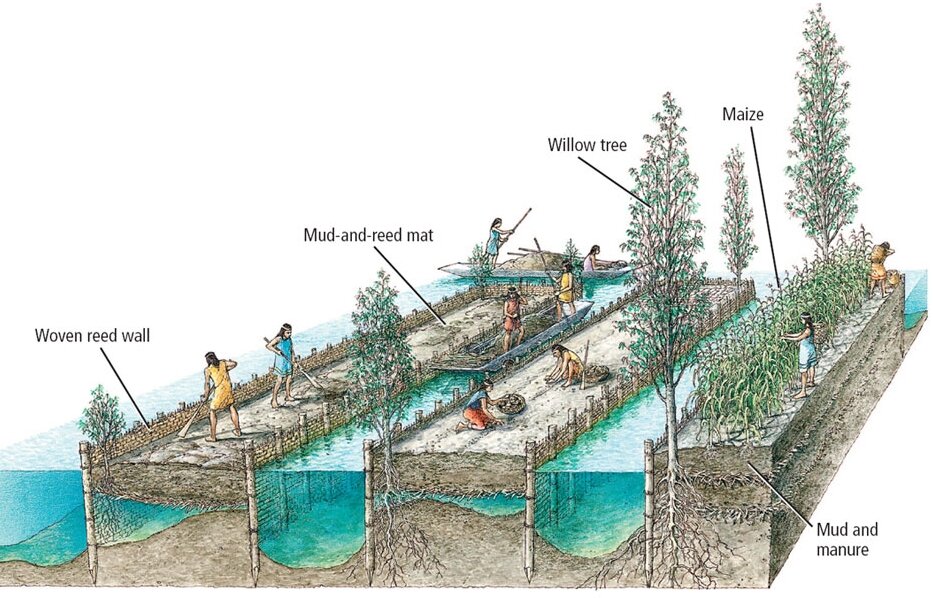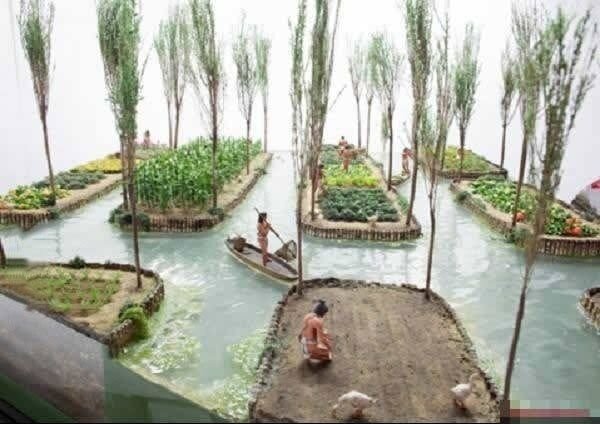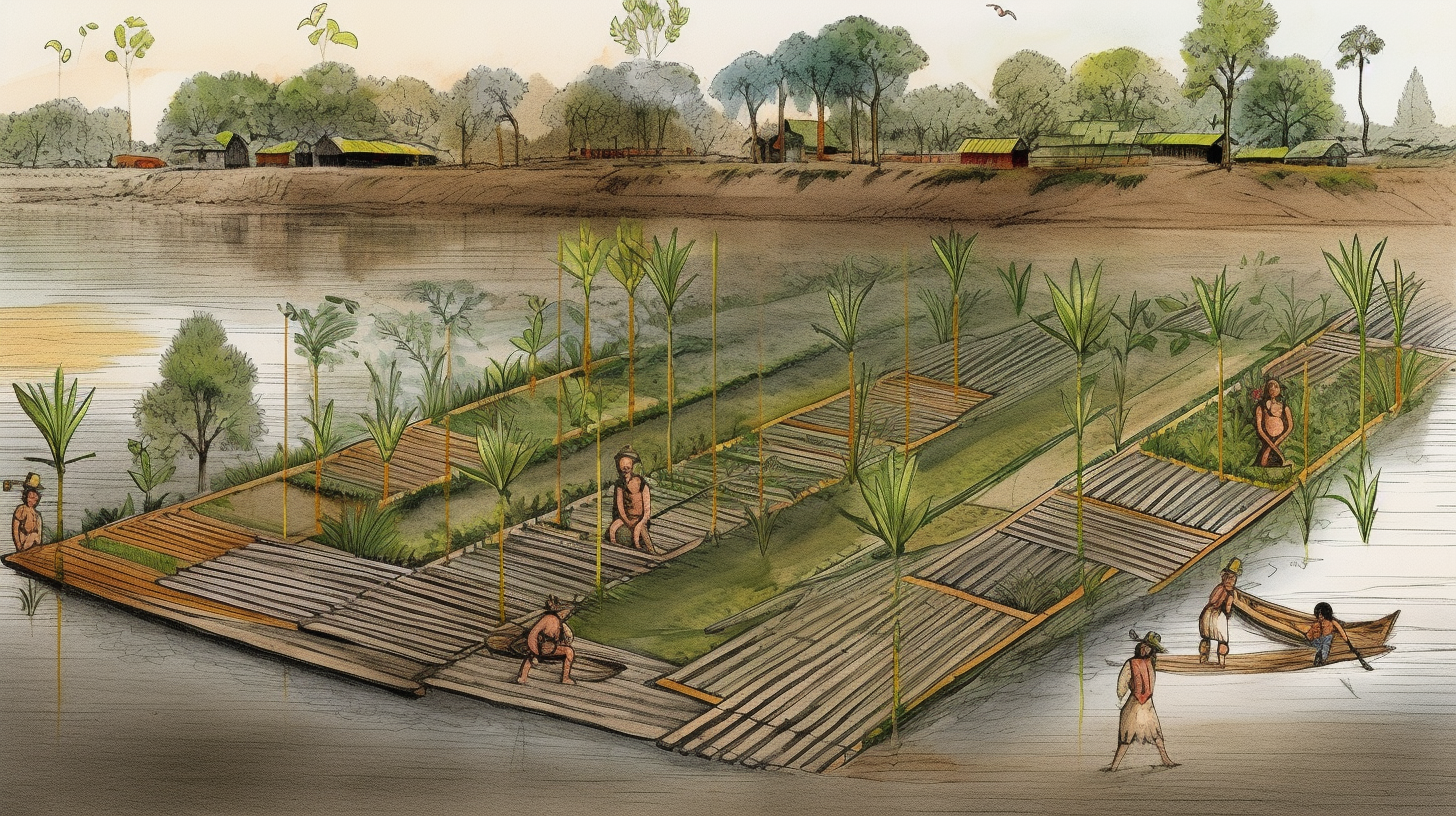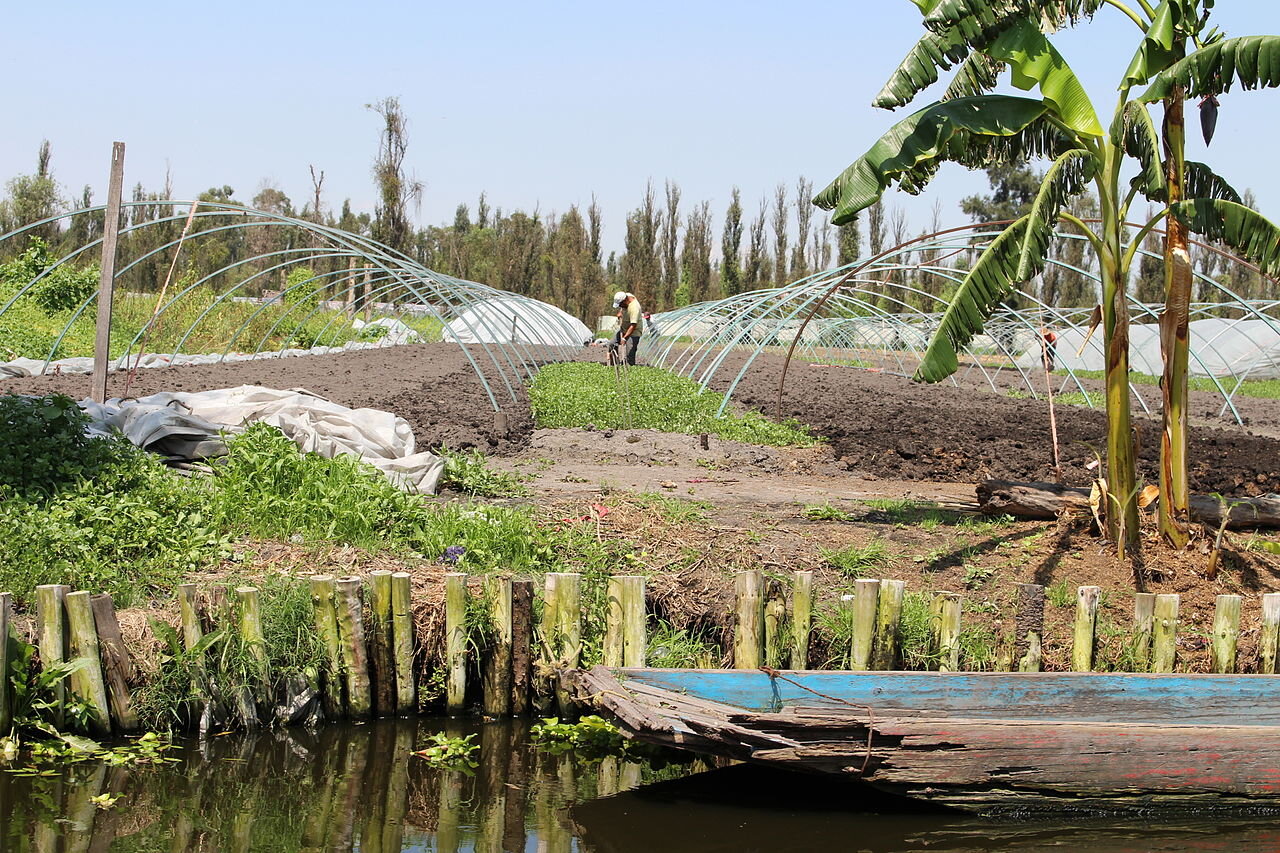In the face of rapid urbanization and growing global population, modern societies are increasingly grappling with the urgent need for sustainable food production solutions. One such solution lies in the ancient Aztec agricultural technique known as 'chinampas', or floating gardens. This ingenious practice holds significant promise for addressing the challenges of urban agriculture and food security in the 21st century.
The Mesoamerican agriculture method known as chinampa (Nahuatl languages: chināmitl [tʃiˈnaːmitɬ]) relies on small, rectangular plots of fertile arable ground to cultivate crops on the shallow lake beds in the Valley of Mexico. They are constructed for agricultural use on freshwater swamps or lake wetlands, and their proportions guarantee the best moisture retention.
The History of Chinampas
The chinampas were developed by the Aztecs around the 14th century in the Valley of Mexico, primarily in the shallow lakes of Xochimilco and Chalco. This region, now part of Mexico City, provided a fertile ground for the growth of the Aztec civilization. The chinampas were created by building small, rectangular plots of land on shallow lake beds, made from layers of mud, decaying vegetation, and other organic matter. These plots were surrounded by canals, allowing for easy transportation and irrigation.
Although the Post-classic and Colonial periods in the basin used various technologies, chinampas have highlighted many concerns about agricultural production and political growth. One of the earliest methods of imperial expansion after the formation of the Aztec Triple Alliance was the conquest of city-states in the southern basin, such as Xochimilco. Prior to this, farmers in the freshwater lakes of Xochimilco and Chalco maintained modest chinampas close to their homes and villages.
The Aztec culture is credited with creating chinampas. Chinampas, often known as "floating gardens," are man-made islands that were built by braiding reeds with stakes below the water's surface to form underwater fences. These "fences" would accumulate soil and aquatic vegetation up until the top soil layer was exposed on the water's surface. Because of the illusion they created, these agricultural regions were given this moniker. The canals encircled the chinampa plots, giving the impression that the areas of land were "floating" on the water.
Agricultural Innovation
The chinampas proved to be highly productive and sustainable agricultural systems. Due to the nutrient-rich materials used to construct them, they provided fertile soil that could support diverse crops such as maize, beans, squash, tomatoes, chili peppers, and even flowers. The water surrounding the chinampas provided a natural irrigation system, reducing the need for artificial irrigation methods. Moreover, the canals between chinampas were home to fish and aquatic birds, creating a balanced ecosystem that supported both plant and animal life.
The lake system within the Valley of Mexico at the time of the Spanish Conquest, showing distribution of the chinampas.
As part of the construction process for chinampas, a drainage system was also created. This drainage system had multiple functions. To facilitate the movement of water and sediments, maybe even night soil, a canal was made. The ditch would gradually fill with mud over time. The obstruction would then be removed by digging up some of this mud and spreading it across the chinampas. Because the dirt at the lake's bottom was so nutrient-rich, it served as an efficient and effective fertilizer for the chinampas.
Rich crops were made possible by adding lost nutrients to the topsoil. Embarcadero-Jiménez and associates investigated the relationship between soil bacterial diversity and environmental factors. A wide variety of bacteria may have an impact on the nutrients in the soil, according to theory. The findings showed that cultivated soils have higher levels of bacterial diversity than non-cultivated soils. Also, "the organization of the bacterial communities indicated an unusual link of the S-cycle and iron-oxidizing bacteria with the rhizosphere of plants cultivated in the chinampa soil and showed that the chinampas constitute a transition system between sediment and soil."
Chinampas were likely enumerated in groups of seven and measured in matl (1 matl = 1.67 meters), according to evidence from Nahuatl wills from late seventeenth-century Pueblo Culhuacán. One researcher used the Codex Vergara as a source to determine the size of chinampas. They were made by marking the small lake bed with stakes and enclosing it with a wattle fence. Later, layers of muck, lake sediment, and decomposing plants were added to the fence-lined area, raising it over the lake's level. To protect the chinampa, trees like huextl (Salix bonplandiana), a willow, and huhutl (Taxodium mucronatum), a cypress, were frequently placed at the corners.
The lengthy raised beds were sometimes interspersed with ditches, which provided plants with constant access to water and made the crops planted there independent of rainfall. Channels big enough for a canoe to pass between Chinampas. With up to 7 harvests each year, these elevated, well-watered beds produced extremely high crop yields. Prior to European colonization, Chinampas were widely utilized throughout Mexico and Central America. There is proof that the earliest chinampas were built in C.E. 1100 at the Nahua village of Culhuacan, which was located on the southern tip of the Ixtapalapa peninsula, which separated Lake Texcoco from Lake Xochimilco.
Aztec maize agriculture as depicted in the Florentine Codex with the cultivator using a digging stick
Relevance for Modern Urban Agriculture
As urban populations continue to expand, traditional agricultural practices are becoming increasingly unsustainable due to land scarcity and environmental concerns. The chinampas system offers several benefits that could help address these challenges:
Space Efficiency: Chinampas maximize the use of limited space in urban environments, enabling food production in areas that might otherwise be unsuitable for agriculture. By creating floating gardens on bodies of water, chinampas allow for the productive use of urban waterways.
Biodiversity: The chinampas system promotes biodiversity by creating a rich, interconnected ecosystem that supports both plant and animal life. This leads to healthier and more resilient crops, reducing the need for chemical inputs.
Sustainable Water Management: The chinampas' natural irrigation system conserves water and reduces the need for energy-intensive pumping and distribution systems.
Carbon Sequestration: The organic matter used in chinampas construction, combined with the plant life it supports, helps capture and store carbon, mitigating the effects of climate change.
Community Engagement: Chinampas can foster social cohesion and promote urban greening by engaging local communities in food production and providing green spaces for recreation and relaxation.
Modern Chinampas around the world
The potential of chinampas has not gone unnoticed. Various projects around the world have been inspired by this ancient technique, including the Floating Gardens of Bangladesh, the Green Float project in Osaka Bay, Japan, and the Urban Rivers project in Chicago, USA. These projects showcase the versatility and adaptability of chinampas in addressing food security, environmental sustainability, and urbanization challenges.
In addition to San Luis, Tlahuac, and Mixquic, chinampas are still extant at San Gregorio, a small village east of Xochimilco, as of 1998. Several of these land parcels still exist and are in use, despite the fact that many of these floating gardens were built and meticulously maintained from the Postclassic Period through the Spanish conquest.
Several of these chinampas have been permitted to overgrow by modern farmers.
While others choose to utilize kayaks for farming, more and more people are relying on wheelbarrows and bicycles for transportation.
Some fields have been purposefully filled in, including ones in the San Gregorio and San Luis areas.
Some of the fields are organically connected together when the canals dry up. Although not used for their original purpose, they are commonly used for cattle feed.
An example of a modern-day chinampa.
Other fields, both dried and surrounded by canals, produce foods such as lettuce, cilantro, spinach, chard, squash, parsley, coriander, cauliflower, celery, mint, chives, rosemary, corn, and radishes. The young leaves of quelites and quintoniles, which are often mistaken for weeds, are grown and harvested as ingredients of sauces. Flowers also continue to be grown on these plots. Some chinampa fields are even used as tourist sites.
From La Chinampa a Tu Mesa, which translates to "From the Floating Isle to Your Table," serves as both. Chinampas, many of which can be found on the canals of Xochimilco, are used by his company in collaboration with local farmers to revive traditional agriculture. Rodriguez has combined conventional production methods with cutting-edge technologies in an effort to preserve the effective and long-standing chinampa agricultural method. Consumers can register on his website to have fresh vegetables picked collected in the chinampas delivered to their homes.
We (De La Chinampa a Tu Mesa) help generate demand, which motivates them (chinampa farmers) to keep farming. And this helps restore the chinampas. The market is starting to recognize the value of the chinampas.
— Ricardo Rodriguez
Despite the fact that many townspeople and farmers are pleased to be returning to their agricultural heritage, they nonetheless confront a number of difficulties. Many of the lakes were drained as part of the Spanish conquest. Sadly, this reduced the lakes' ability to support agriculture, including the lake at Xochimilco. Moreover, an earthquake that occurred in 1985 further harmed a number of the canals. Additional issues include the scarcity of water, the usage of pesticides, climate change, urban development, and water pollution from toxic waste and untreated sewage.
The ancient Aztec chinampas system, with its unique combination of sustainability, space efficiency, and biodiversity, offers a promising solution to the challenges of modern urban agriculture. By embracing this time-tested technique, cities around the world can address food security concerns, promote environmental stewardship, and enhance the well-being of urban residents.














